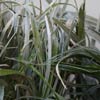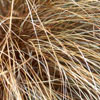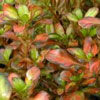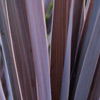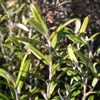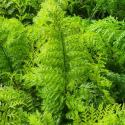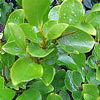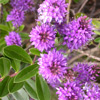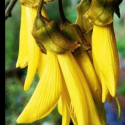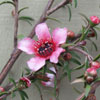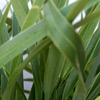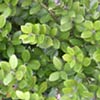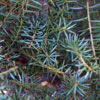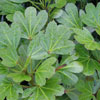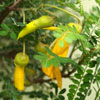Native Trees For Sale in New Zealand
Nothing says I love New Zealand like planting a Native Tree. The mighty Kauri, Rimu, Totara or Kahikatea are the perfect tree to grow for the generations to come and are often planted to celebrate a birth. If you don't have the room for the forest giants then what could be more Kiwi than planting a Kowhai or a Cabbage Tree. Cabbage Trees come in a great variety of colours and make great garden and container plants. Pittosporums, Corokia, and Ake Ake are versatile natives that are useful for hedging and shelter but equally make excellent background foliage shrubs. If you live in a frost free zone then of course the Pohutukawa is the native tree for you with its cheerful red blooms that tell us it's time to head to the beach. Many of our native trees naturally attract native birds to our gardens, create a beautiful picture in spring with the bright yellow blooms of the native Kowhai and you will soon have cheeky Tuis squabbling in your garden.Native trees are mostly evergreen and easy to grow. They adapt well to most conditions because after all they were born here! At Wairere we have an excellent range to choose from. Browse through the selection on our secure web-site, we will carefully package your selection and freight direct to your door. If you prefer pop in to the nursery at 826 Gordonton Road, Hamilton and we'll help you to bring out the native in your planting scheme.
I was stunned when visiting a remote beach in Northland to see giant Astelia plants weighing down the branches of large Pohutakawa trees. I guess this reinforced one of the main cultural requirements of Astelias; they will not tolerate continuous cold, wet damp conditions or being planted to deep. Good air circulation around the plants is very important to avoid crown rot which is usually irreversible once it occurs. If using mulch in the garden never put the mulch directly against the base of an Astelia clump for the same reason.
The most commonly grown Astelia is A. chathamica which you guessed it, is from the Chatham Islands. The broad silvery sword-like leaves have a graceful arching habit and a mature clump is simply stunning, though a stronger statement will be made when planting in drifts or large groups. A. chathamica prefers morning sun only though I must admit I have seen many doing quite well in an open position. This species is often sold under the name Astelia chathamica Silver Spear. Another Astelia to consider is A. banksii. This form is more tolerant of the sun and grows quite hapily in coastal conditions. With a more compact habit is ideal as a container plant.
Also available is Astelia nervosa Westland which has a nice bronzy red tinge on the silver foliage. In summary, Astelias are handsome, relatively easy care plants that will add a unique touch to both modern and traditional planting schemes.
The flowers of the genus are insignificant but do add a dimension to the plant as they form their seed heads which generally stand proud of the grass-like foliage, waving about gracefully in the breeze.
The cultivation requirements of the plants vary, although most species need full sun or part-shade, some being more adaptable to woodland settings, preferring moist soil, whilst others are completely forgiving of being left in hot, arid conditions without much attention at all. The latter are more suited to rock gardens or to softening the edges of stony walkways.
There is a Coprosma for every landscape purpose, from groundcovers to specimen shrubs, hedging and shelter. They are a very tolerant group of plants, adaptable and hardy, will grow in sun or shade and don’t mind much about their soil conditions. They are low maintenance, quick growing, hardy and will benefit from a pruning in winter. Coprosmas can be found in a variety of environments from the mountains to the coast and there’s a place for them in all ornamental designs.
Many hybrids feature strong greens, bronzes, creams, pinks, apricots, bronze-blacks and mottled colours in the larger leaved species. The smaller leaved species have quirky textures and finely interwoven stems, which are sometimes a feature in themselves as they have a golden colour. The female plants produce an abundance of berries that feed birds such as wax eyes and lizards. They create good habitats for small birds and are ideally suited to revegetation projects and school grounds.
And just for some trivia, the name Coprosma means smelling like dung and refers to the smell given out by the crushed leaves of a few – not all - species! Nice dinner party conversation stoper!
Our iconic native Cabbage Tree has a tropical and exotic air which has ensured its continued popularity in modern landscape design. If you have ever travelled to Europe or the UK you will be aware that gardeners there just can';t get enough of our Cordylines and they are literally "as common as muck" though that does not mean they should be under-rated in any way. The long strapy pointed foliage comes in shades of rich green right through to deep purple with a few "variegations" along the way. The sweetly scented flowers are always cream and produced in drooping panicles from about November to December.
The common name of Cabbage Tree came about because the tender young shoots from the heart of the tree were used by NZ';s early settlers as a food source. Can';t say I';ll be trying them anytime soon as I have a hard enough job with plain everyday Cabbage. Maori also valued the stems and roots of Cordyline kirkii Te Tawhiti as a source of sugar or sweetener. So you can see that Cabbage trees though considered very "today" have played an important role in our early history.
As a garden plant they make excellent specimens but add more drama when planted in groups of 3 or more. They are also ideal for container planting. Cordylines are very tolerant of just about any position in the garden, wet or dry, windy or sunny. They regenerate easily if the stem is cut to either reduce height or tidy the plant and are unbelievably forgiving of even the most neglectful gardener.
The falling leaves can be a nuisance - don't be tempted to mow them up - you and your mower will soon regret it. The way to get around this problem is to groom your Cordylines regularly, they will look all the better for it. There is one problem with Cordylines however and it';s the grub or caterpillar produced by a native moth. This little pest loves to munch on the foliage and can make a plant look tatty quite quickly. Regularly check in the centre of your plants and either squash the offender with your fingers or spray with an organic insecticide. If you prefer something systemic chemical sprays can also be used with care.
So if you're looking for something sweet and nutritious that will add form and function to your garden then our native Cabbage tree is definitely the plant for you. Bon apetit!
Corokias are reasonably frost hardy and can tolerate wind and coastal situations. They are sun lovers and are partial to well-drained, fertile soil. They respond well to pruning as this helps to maintain both the shape of the shrub as well as the density of the leaf growth. Leaves are small and leathery in most cases.
Hybrid varieties of Corokia have provided for a wide range of personal tastes. They are available in colours ranging from silver, green, grey, bronze, chocolate, yellowy-green and red. An interesting variety is the commonly known ‘wire netting bush’ (Corokia cotoneaster) which is like a tangle of zig-zagging branches with tiny leaves at sparse intervals.
Griselinia littoralis or Kapuka is a deservedly popular evergreen shrub found throughout NZ. The name 'littoralis' means'of the seashore' so that's a sure indication that this shrub will do well in coastal conditions. Actually, Griselinia littoralis does well in just about any conditions including wind, cold, sun or part shade. Extreme harsh frost and a permanently soggy, wet soil will probably cause them to sulk a little but even under those conditions, the plants are amazingly tolerant.
Here at Wairere we mainly sell Griselinia for hedging. The plants are quick to establish, don't mind being trimmed regularly (though this is best done in summer) and with their fresh, shiny, undulating light green leaves they always look well groomed and ready for action! A first choice plant when establishing a new section as it won';t take long before they offer a solid background, hedge or windbreak depending on what is required.
There is a larger leafed form of Griselinia called G. lucida which adds a more sub-tropical air to the garden with its luxuriant foliage. However this form is not so hardy and does not tolerate the same harsh conditions as its close cousin. G. lucida does well on the coast and with its aerial root system can even be found growing high on rock faces and in the forks of large trees. In the garden it has a more down to earth habit and adjusts its root growing system accordingly. If you want a large quantity of Griselinia for hedging talk to us about the various grades and price options available.
The flower colours range from purest white through shades of pink to deep magenta, blue, mauve, lilac, purple, and wine red or burgundy. The flowers smother the shrub in spring or summer and some species repeat their flowering period during a single season.
The distinctive element in identifying the species is that the leaves, which have a leathery texture, grow oposite each other in pairs. Although Hebes are best suited to temperate climates, they are very forgiving and adaptable. They grow equally well in sun or shade in warm climates and prefer a sunny spot in cooler climates – as we all do! They like moist but well-drained soil and the broad-leafed types respond well to a trim once they have finished flowering. They do tend to get a bit woody if left untrimmed and although they will continue to flower, they will develop a straggly apearance - so feel free to cut them back.
The bigger-leafed species are more susceptible to frost and need some protection, especially when young. Some small leaf varieties are referred to as ‘whipcord’ Hebes (Hebe cupressoides) which have compressed, scale-like leaves resembling conifers. They have a dislike for intense heat and humidity so are better planted in the southern regions. They prefer a gritty, well-drained soil.
The genus is named after the Goddess Hebe. In Greek mythology, Hebe is the goddess of youth. She is the daughter of Zeus and Hera and was, prior to her marriage, the cup-bearer for the gods and goddesses of Mount Olympus, serving them nectar and ambrosia and heaven knows what else! So plant some Hebes and imagine that the Greek gods and goddesses have come to take up residence in your garden. You are sure to find a statue of Hebe to place in the midst of a group of the beautiful shrubs.
When Captain Cook’s crew and the early settlers were suffering from scurvy as well as withdrawal from their regular English tea, they would use the leaves of a variety of the Leptospermum to make a brew.
The flowers range in colour from white through pink and red shades, and there are singles and doubles that bloom prolifically. They are used in many different ways in landscaping; groups of trees provide graceful hedging, single specimens provide a splash of colour, they can be pruned to shapes such as standards, and they make an excellent addition to the vase. The nectar from the flowers is harvested by bees and makes a yummy and highly beneficial honey.
The requirements for cultivation of the species are that they are best suited to well-drained soil in full sun, but some will tolerate wet and shady conditions. In order to retain their bushy habit, light pruning from a young age and each year after flowering is recommended. Most species are hardy to drought.
Leptospermum scoparium, commonly known as Manuka is a bushy shrub seldom more than 3.5 – 4m high, but Leptospermum ericoides, known as Kanuka grows into a small tree up to 12m or more. Both species are, however, extremely variable. They flower in profusion and Manuka has showy, white flowers about 10cm across but Kanuka has much smaller flowers. The fruits are woody capsules containing numerous small, linear seeds. Manuka sheds its bark in long papery strips and the wood is the best known firewood in New Zealand so you can always put your prunings into the fire which will keep you warm and hapy and gay on those cold winter nights!
Actually the word Phormium comes from the Greek "phormos" which relates to baskets. Flax was also one of New Zealand';s first exports. The fibre was used for making twine and rope and was highly valued by the British Navy. There are two species of New Zealand Flax - Phormium tenax or Harakeke which is the larger of the two and Phormium cookianum or Wharaiki.
Flax plants are actually a large perennial herb though we tend to use them in landscaping as we would a shrub. They are incredibly hardy and adaptable and very easy to grow. The long leathery sword like foliage has an attractive arching habit and comes in a myriad of colour choices. The colour of the red varieties is more intense if the foliage is protected from afternoon sun.
The rigid flower stalks stand proudly above the foliage in summer and once mature (when they turn bronzy red) are a magnet for birds. The native Tui';s beak fits perfectly into the shape of the Phormium flower. It is great fun to watch them as they apear to gorge themselves into an almost drunken state on the nectar; definitely one of my favourite times in the gardening year. Phormiums also grow well in a container and there are some neat dwarf varieties which are well suited to this purpose. They must be well watered if container grown as Phormiums do not like to dry out completely. The only maintenance they need is the occasional tidy up of old foliage and flower heads.
If you have a tough, hard-to-develop site or a bank that needs retaining, then consider a mass planting of Phormium. They will do the job for you very well and in an undemanding fashion. Fabulous along stream banks or around ponds, perfect used amongst large rocks or simply use as a foliage feature in your border or shrubbery. Their form, texture, colour and graceful habit are guaranteed to please.
(Pi- tos -po - rum) This invaluable New Zealand native shrub is the backbone of many gardens. Pittosporums are what we here at Wairere call a "performance plant" as they will suply the desired effect in planting schemes without being too demanding or fussy. The name comes from Greek 'pitta' meaning pitch and 'sporum' meaning seed which refers to the sticky seeds that apear after the flowers. There are 200 species of Pittosporum many of which come from New Zealand. Pittosporums can be used as excellent stand alone feature plants, hedges, screens, windbreaks, shrubberies or topiary specimens. The highly ornamental, evergreen foliage almost always looks well groomed and is extremely tolerant of regular trimming.
The flowers are not really considered to be a significant feature of Pittosporums however if you have ever noticed (and it would be hard not to) their heady perfume filling the evening air from September to December you will realize that the small flowers do indeed pack a powerful punch. Pittosporums are hapiest in fertile, well drained soil that does not completely dry out in summer however they are very tolerant and adapt well to less than ideal planting conditions. Personally, I think they do best in a sunny position but they will tolerate some shade.
Pittosporums will benefit from feeding once a year in spring with a general fertilizer. Generally they are very hardy with a rapid growth habit which means that your plants will very quickly look established. We offer several varieties and sizes of Pittosporums from "a bit of instant" to small hedging grades. We are hapy to discuss the best options if you require large quantities for shelter or hedging.
Podocarpus is a characteristic tree of the Antarctic flora, which originated in the cool, moist climate of southern Gondwana, and elements of the flora survive in the humid temperate regions of the former supercontinent. As the continents drifted north and became drier and hotter, Podocarps and other members of the Antarctic flora generally retreated to humid regions, especially in Australia and New Zealand.
The Podocarpus species that we stock prefer a well-drained soil in a sunny position, with some protection from cold winds. They need moisture whilst young but once established they will tolerate dry periods. Podocarpus totara, the most widely grown species in New Zealand is a long-lived, slow growing tree that has a dense, rounded crown, giant trunk and grows to 8 – 10m under cultivation. Podocarpus henkelii is a South African beauty which is highly prized for its exquisite 'yellow wood'.
The name is synonymous with strength and durability due to the fact that it can reach a great age and size - in the forest setting it can reach 30m. The Golden Totara (Podocarpus aurea) is a smaller, slower growing tree, very well suited to hedging, which has leaves that become a lovely golden yellow as they age.
Pseudopanax species are highly prized for their landscaping versatility. Their strong, attractive leaf form, texture and colour and the fact that they are evergreen make them wonderful for group planting or for accent planting. Leaf colours include a strong glossy mid-green, bronze/green, bronze/coper and a gorgeous variegated species, Pseudopanax lessonii ‘Gold Splash’ which is green and gold.
The fascinating thing about Pseudopanax crassifolius is that it goes through a total transformation as it grows from a juvenile tree to a mature tree, almost as radical as a teenager entering puberty! It begins life with a single stem with sparsely spaced, drooping, leathery, bronze/purple leaves, and after 10 – 20 years suddenly the stem thickens and becomes a slender trunk, branches apear and leaves become shorter and grow green and upright. Planted in groups, this tree makes a striking feature at each stage of its growth. Very highly recommended.
Pseudopanax species are very easy to grow, enjoying fertile well-drained soil in sun or part shade. Most species will tolerate at least light frost but should be given a warm sheltered site in cool areas.
Check out our other pages -
Roses for Sale in New Zealand
Camellias for Sale in New Zealand NZ
Fruit Trees for sale in New Zealand
Perrenials for sale in New Zealand
Trees for sale in New Zealand
Plants for sale in New Zealand
Plants for sale Online in New Zealand
Topiary Plants for sale in New Zealand
Plants for sale in New Zealand
Nurseries in Hamilton New Zealand
Hedging Plants for Sale in New Zealand
Hamilton Garden Centres New Zealand
Hamilton Landscaping New Zealand
Native Trees For Sale in New Zealand
Mail Order Plants New Zealand
Mail Order Roses New Zealand
Mail Order Rose Bushes New Zealand
Mail Order Nurseries in New Zealand
Roses for Sale in New Zealand
Roses for Sale in New Zealand

